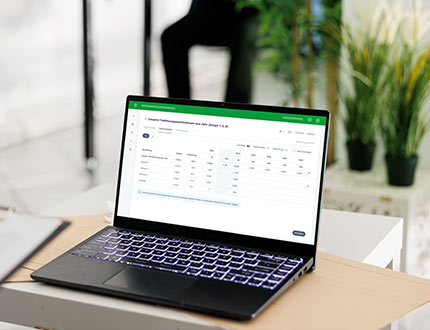Calculate Carbon Footprint Precisely with Software Support
In accordance with the Greenhouse Gas Protocol and ISO 14064. Complete from Scope 1 to Scope 3. Automated, digital, precise.
Carbon Accounting with leadity
GHG Protocol and CSRD-Compliant Carbon Footprint
Developed with over twelve years of experience in carbon accounting and more than 200 successfully completed carbon footprints. Your CO₂ balance sheets are automatically integrated into your entire reporting. Leadity is carbon accounting and sustainability management in one system.
-
Guided introduction, rapid data collection:
Swift data capture through selection options and data templates. -
Calculation of all Scope 1, 2 & 3 emissions:
Comprehensive footprint of your company and its value chain.
-
Automated efficient calculation:
Automated data collection via interfaces and calculation through linked CO2 databases. -
Well-founded, audit-proof accounting:
CSRD-compliant according to the Greenhouse Gas Protocol and ISO 14064-1.

ESRS-Compliant Balance Sheet
CO2 Reporting and Management
Intuitive dashboards make your emissions visible at a glance. Identify which areas of your operation are the largest CO2 emitters and take measures to decarbonise.
Interfaces with existing systems and key performance indicators enable automated data capture. Pre-set baseline values for materials, services, transport emission calculations and much more facilitate manual entries.
Your emission data are automatically assigned to Scope 1, 2 or 3.
From Small SMEs to Global Corporations
Whether Retail, Service or Manufacturing Industry
The integrated leading emission databases (Ecoinvent, Gemis, Defra, fjol climate database, and many more) make it easy for you to calculate your individual emissions in detail.
All carbon footprints can be validated externally by independent third parties with minimal effort upon request. Furthermore, the calculation method is currently being certified externally by TÜV Rheinland (third-party validation).

Software-Supported Carbon Accounting for Companies
leadity Simplifies Your Carbon Accounting
Legally compliant for your CSRD reporting according to the Greenhouse Gas Protocol and ISO 14064.
Capture your Corporate Carbon Footprint and have it automatically integrated into your remaining sustainability reporting. Without duplicate efforts, smart and efficient.
We’d be happy to show you your advantages in a personal demo appointment.
Carbon Footprint Software
Advanced Software Features
The carbon footprint is just one of many integrated modules in the leadity software. Whether it’s strategy, sustainability management or reporting in accordance with ESRS/CSRD, or risk screening of your supply chain for the Supply Chain Due Diligence Act (CSDDD), leadity offers numerous functions to make your sustainability management more efficient.
FAQs
Questions and Answers About Carbon Footprint
If you have any questions about climate balancing in leadity, please do not hesitate to contact us: kontakt@leadity.de
In Germany and the European Union, certain companies are legally required to prepare a CO2 balance sheet:
- Energy-intensive companies: Companies participating in the EU Emissions Trading System (EU ETS) must report their greenhouse gas emissions. This mainly affects energy-intensive industries such as steel, cement, chemical, and energy production companies12. Companies subject to the Carbon Border Adjustment Mechanism (CBAM) must also account for CO2 values of certain purchased goods.
- CSRD-obligated companies: All companies meeting the criteria of the EU Non-Financial Reporting Directive (NFRD) must submit a CO2 balance sheet under the updated CSRD directive. This typically applies to companies with more than 500 employees that are of public interest (e.g. listed companies).
- Companies preparing voluntary reports: Many companies voluntarily prepare CO2 balance sheets to transparently demonstrate progress in CO2 reduction or to meet investor and customer requirements.
- Specific industry regulations: Certain industries have their own regulations or agreements on CO2 reporting. For example, large real estate companies must collect and report specific data.
Connection to CSRD: The European Union’s Corporate Sustainability Reporting Directive (CSRD) expands and deepens sustainability reporting requirements. It applies to all large companies and all listed companies (except micro-enterprises). Companies must disclose detailed information on environmental factors, social and employee matters, human rights, anti-corruption, and particularly climate and CO2 emissions. Reports must be prepared according to European Sustainability Reporting Standards (ESRS) and verified by independent third parties. The CSRD also promotes digital reporting, improving the comparability and transparency of sustainability data, including CO2 emissions.
The CSRD not only requires companies to prepare a CO balance sheet but also to publish it in a standardised, verifiable, and detailed format, which can contribute to better monitoring and reduction of CO2 emissions.
Scope 1, 2 and 3 emissions are categories for classifying a company’s greenhouse gas emissions in accordance with the Greenhouse Gas Protocol, a globally recognised standard for measuring and managing greenhouse gases. Here is an overview of the individual emission categories in the three scopes:
Scope 1: Direct Emissions
Scope 1 includes all direct emissions that originate from sources within the company’s boundaries and can be directly controlled by the company. These include:
- Combustion of fossil fuels in company-owned or controlled facilities, such as boilers, vehicles and production facilities.
- Process emissions from industrial processes, e.g. in the production of cement or steel.
- Fugitive emissions from sources such as leaks in refrigeration systems or from the use of chemical compounds.
Scope 2: Indirect Emissions from Energy Consumption
Scope 2 includes indirect emissions caused by the consumption of purchased energy. This includes:
- Power consumption: Emissions, that arise during the generation of the electricity that the company purchases.
- District heating and cooling: Emissions from the generation of heat or cold that the company uses but does not produce itself.
Scope 3: Other Indirect Emissions
Scope 3 includes all other indirect emissions that occur along the company’s value chain, both upstream and downstream. Examples are:
- Upstream emissions: Emissions from the production and transport of purchased goods and services, business travel, employee commuting and waste disposal.
- Downstream emissions: Emissions from the use and disposal of products sold by the company, transport and distribution.
The recording and management of Scope 3 emissions are often more complex than for Scope 1 and 2, as they involve numerous external processes and actors.
This categorisation helps companies to better understand and manage their overall emissions by taking into account not only the direct and controllable emissions (Scope 1 and 2), but also the comprehensive indirect emissions along their value chain (Scope 3).
Carrying out climate balancing with leadity offers you numerous advantages:
1. Time and Cost Savings
- Increased efficiency: leadity speeds up the process of collecting and analysing data, which reduces the workload and makes reporting faster.
- Cost reduction: The automation and reduction of manual processes available in leadity allow you to reduce the costs of your climate accounting.
2. Accuracy and Efficiency
- Automation: leadity automates data collection and processing, which reduces human error and increases the accuracy of results.
- Data integration: You can integrate data from different sources and systems, providing a more comprehensive and accurate picture of emissions.
3. Compliance and Standardisation
- Regulatory compliance: The leadity software ensures that reporting complies with legal and regulatory requirements, such as the CSRD (ESRS) or ISO 14064.
- Standardised reporting: In addition, leadity ensures compliance with international standards and frameworks, such as the GHG Protocol (Greenhouse Gas Protocol), which improves the comparability and consistency of the data.
4. Sustainability Management and Decision-Making
- Analysis and reporting: With leadity, companies can create detailed reports and analyses that help them to better understand and manage their emission sources.
- Strategic planning: leadity supports you in the strategic planning and management of sustainability initiatives by identifying reduction potential and monitoring progress.
- Data visualisation: leadity offers visual representations of the emissions data that make it easier to understand and communicate the results.
5. Scalability
- Flexibility: leadity is scalable as a sustainability system and can be customised to your individual needs.
- Future-proof: The leadity software enables you to continue and expand your climate accounting with growing data volumes and changing requirements.
- Consolidation: The group function can be used to automatically consolidate CO₂ balance sheets from different locations and companies. A central platform ensures congruent data.
By using leadity for your carbon footprint, you can measure, monitor and report your greenhouse gas emissions more efficiently and effectively, helping you to both comply with legal requirements and achieve your sustainability goals.
We would be happy to show you in detail how this works.
Request a non-binding software demo here
The Greenhouse Gas Protocol (GHG) is a comprehensive global standard for measuring and reporting greenhouse gas emissions. It was developed by the World Resources Institute (WRI) and the World Business Council for Sustainable Development (WBCSD) and serves as the basis for numerous national and international greenhouse gas inventory programmes. The GHG Protocol provides guidelines and tools for companies and governments to prepare greenhouse gas inventories and supports them in setting and achieving reduction targets.
The most important components of the GHG Protocol include:
- Corporate Standard: Guidelines for companies to prepare a comprehensive greenhouse gas balance sheet, including the categorisation of emissions into Scope 1, 2 and 3.
- Project Protocol: Framework for quantifying the reduction of greenhouse gas emissions from specific projects.
- Value Chain (Scope 3) Standard: Guidelines for reporting emissions along a company’s entire value chain.
ISO 14064-1
ISO 14064-1 is part of the ISO 14064 series of standards and provides an internationally recognised standard for quantifying and reporting greenhouse gas emissions at an organisational level. This standard is published by the International Organisation for Standardisation (ISO) and is an important addition to the guidelines of the GHG Protocol.
Important features of ISO 14064-1 include:
- Clearly defined requirements: Specifications for the preparation of greenhouse gas balances, including the identification of emission sources, the selection of recording methods and the reporting of emissions.
- Reliability and transparency: Guidelines to ensure the accuracy and consistency of the reported data, as well as the transparency of the methods and assumptions used.
- Reporting and verification: Requirements for internal and external verification of emissions data to increase the credibility and reliability of the reports.
ISO 14064-1 is designed to help organisations systematically record and manage their greenhouse gas emissions, which contributes to the achievement of sustainability goals and compliance with regulatory requirements.
Summary
The Greenhouse Gas Protocol and ISO 14064-1 offer standardised approaches for measuring, reporting and verifying greenhouse gas emissions. Both standards contribute to the improvement of environmental reporting and the promotion of sustainable practices. With leadity, you fulfil both standards automatically and in close alignment.
CO2 Management with leadity
Digital and Efficient CO2 Reporting with leadity
Record and calculate all emissions with the support of leading emissions databases. Thanks to automated interfaces and well-founded base values, you receive a detailed overview of your CO2 emissions – see our software for yourself now.